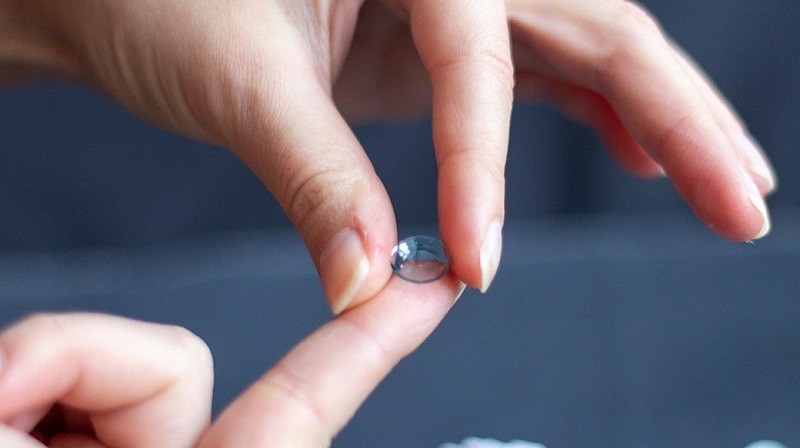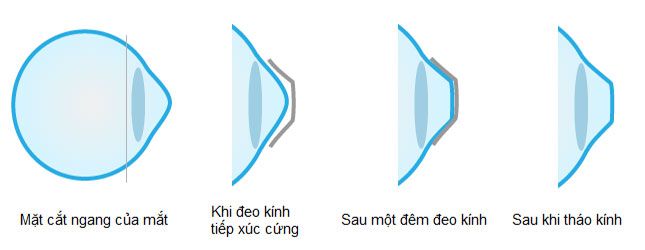Ortho-K lens or Orthokeratology, is a hard gas-permeable contact lens specially designed to be worn overnight and removed in the next morning. It works by flattening the center of the cornea, changing how light is bent as it focuses on the retina. When the patient wakes up and takes out the lenses, he or she should be able to see clearly throughout a certain period of time during the day without wearing glasses or other contact lenses. These overnight lenses are gas permeable, and hard enough to reshape the cornea, and also allow oxygen to pass through so your eye stays healthy.

Ortho-K contact lenses are prescribed for two purposes:
- To correct refractive errors (primarily myopia and astigmatism). By wearing Ortho-K for 6-8 hours overnight, the patient is able to see clearly throughout a certain period of time during the day without wearing glasses or other contact lenses.
- To slow myopia progression in children: This lens acts to inhibit growth of myopia and it can be applied to children with rapid myopia progression.

It is worn overnight
Unlike normal contact lenses, Ortho K is worn while you are asleep and removed when you wake up.
It takes time to get maximum effect
Ortho K lenses take some time to reshape the cornea, so depending on your initial refractive index, your maximum vision will be reached after 1 to 4 weeks on average. For eyes with low myopia, the maximum vision can be reached after a few days. Until your eyes are fully adjusted, they may get blurred vision, glared, and halos around the lights. In some cases, you may need to wear glasses with a lower refractive index in daytime during the orthopedic procedure to support your vision.
Restorability
The corneal reshaping is temporary, so you will need regular Ortho-K lenses. In case you stop wearing them, your corneal shape and eye’s refractive index will be restored.
It’s most effective for mild to moderate myopia
Depending on the lens manufacturer, the treatment threshold of Ortho K can be up to -10 diopters of myopia and -3 diopters of astigmatism. However, it is most effective for eyes of low to moderate myopia (from -1 diopter to -4 diopters) and mild astigmatism (no more than -1 diopter).
- Those with myopia, astigmatism within the treatment threshold of Ortho K lenses (under 10 diopters for myopia and under 3 diopters for astigmatism).
- Children under 18 years old with refractive errors who are not old enough to perform surgery.
- Children with rapid myopia progression.
- Those with difficulty or discomfort in wearing normal-framed glasses or contact lenses


- Those having eye inflammation
- Those having persistent dry eye or tear gland disorder
- Those who are allergic to contact lens in general
- Those having corneal diseases or keratoconus
- Women who are pregnant or planning to become pregnant or are breastfeeding
- Those having autoimmune diseases or diabetes
- Those having abnormality in corneal structure, conjunctiva, or eyelids
- Those having regular red eyes, often feeling stuck inside the eyes
- Those who cannot comply with the prescriptions and instructions of the doctor
- Those who cannot follow routine examination schedule
- Those whose jobs require long-term stable vision
- Those who have irregular astigmatism or unstable corneal refraction
- Those having low sensitivity on the corneal surface
- Those having history of myopia surgery or other eye ones
Ortho K flattens the central corneal area, but does not change the shape of its periphery and hemisphere which causing differences in refractive power in these three corneal parts. This can cause blurred vision or glare and halo. This condition can cause certain discomfort.
Like other types of contact lenses, hard nighttime contact lenses can also cause some eye symptoms such as:
- Tears, red eyes, bulging, entangled, eye mucus
- Dry eyes, sensitivity to light, blurred vision
- Corneal scratch or inflammation
To avoid those symptoms, you should strictly follow the principles of cleaning, using and preserving lenses as well as re-examine them periodically. In case of getting any of those symptoms, you should inform your doctor for guidance and prescription.
SEED “Breath-O Correct” Ortho-K lens (Japan)
Breath-O Correct is the Ortho K series of SEED – Japan and is the top choice for hard overnight contact lenses in this country. Made from exclusive Toray materials, Breath-O Correct lens has many outstanding advantages.
Treatment threshold :
- Myopia: from -1.00D to -8.00D;
- Astigmatism: Under -1.5D for direct astigmatism
ORTHO-K CONTEX OK® E-SYSTEM (BAUSCH & LOMB - USA)
Treatment threshold
- Myopia: -0.75 đến -9.25D;
- Asigmatism: -2.00D
Advantages:
CONTEX OK® is a rigid contact lens with an inverted geometry design. CONTEX OK® lenses made of Boston XO2 material with low UV absorption, high air permeability, ensuring sufficient oxygen supply, which determines the health of the cornea.
FARGO Ortho-K lens (USA)
– Treatment threshold:
- Myopia: -1.00D to -9.00D;
- Astigmatism: Up to 3D
– Advantages
- High treatment threshold for astigmatism
- Under -0.75D for inverse astigmatism
- Advantages:
- High oxygen permeability, safe to cornea
- Good elasticity, resulting in high durability, limiting the risk of cracking during use, easy to handle, and suitable for children.
- Design suitable with corneal structure of Asians
The examination and Ortho K consultation package at the Japan International Eye Hospital consists of the following steps:
Step 1: General consultation to define your eye’s suitability with Ortho K
- Refractive measurement
- Eye pressure measurement
- Vision test
- Consultation by doctor
Step 2: Finalizing lens parameter, fit and order the lens
- Corneal topography
- Finalizing the lens parameters
- Fitting the lens
- Ordering the lens
Step 3: Receiving the lens and instructions for use
- Receiving Ortho K lens which is right to the calculated parameters for your eye.
- The doctor then guide you how to use the lens as well as notes for its storage.
Step 4: Periodic follow-up examination
- Periodic follow-up examination schedule: 1 week – 1 month – 3 months from the date of starting to use Ortho K lens
The periodic follow-up examination helps determine your eye’s suitability and treatment efficiency.
Application instructions
- Start putting the hard contact lenses about 15 minutes before going to bed.
- Before putting them, wash your hands with soap and dry them.
- Apply artificial tears to your eyes.
- Wash your lenses with normal saline
- Check if your lenses and irises have any dust.
- Put your lenses on tip of your pointer finger (dominant hand), apply 1 drop of artificial tears to your contact lenses.
- Look straight to your mirror, keep your lower eyelid down by your right middle finger, keep your upper eyelid by your 3 left middle fingers, and gently place the lens over your iris.
- Lightly release your eyelids, blink and close your eyes for a few seconds, look in the mirror to check that your lenses are at the iris center.
- After putting the lenses, pour out the lens soaking water and leave its tray dry naturally.
Removal instruction
- Apply artificial tears to your eyes. Wash your hands with soap.
- Look straight to your mirror, keep your upper eyelid and lower one using your right middle finger and the left one respectively, and squeeze the lens remover in the center or lower 2/3 of the iris, and gently pick up the lens.
- Gently remove the lens from the remover, and wash it with normal saline. Then, put it in the lens soak tray, cover them with lens soaking water, close they tray cover, and then repeat the procedure for the other eye.

